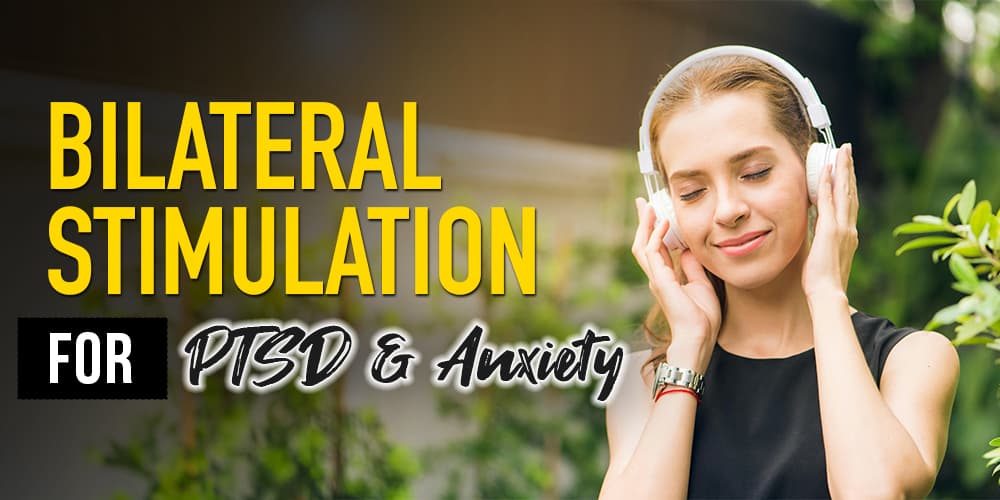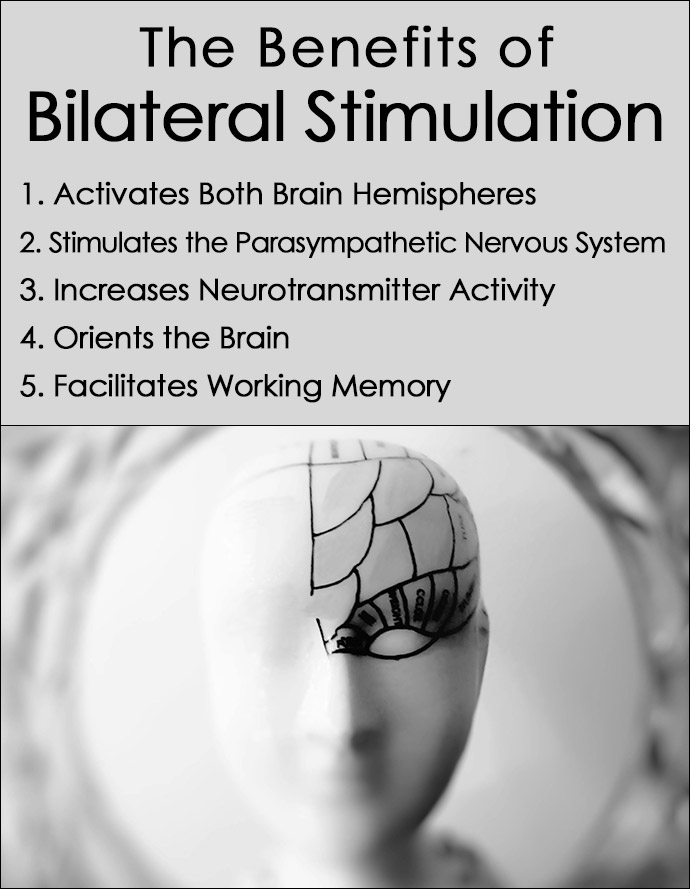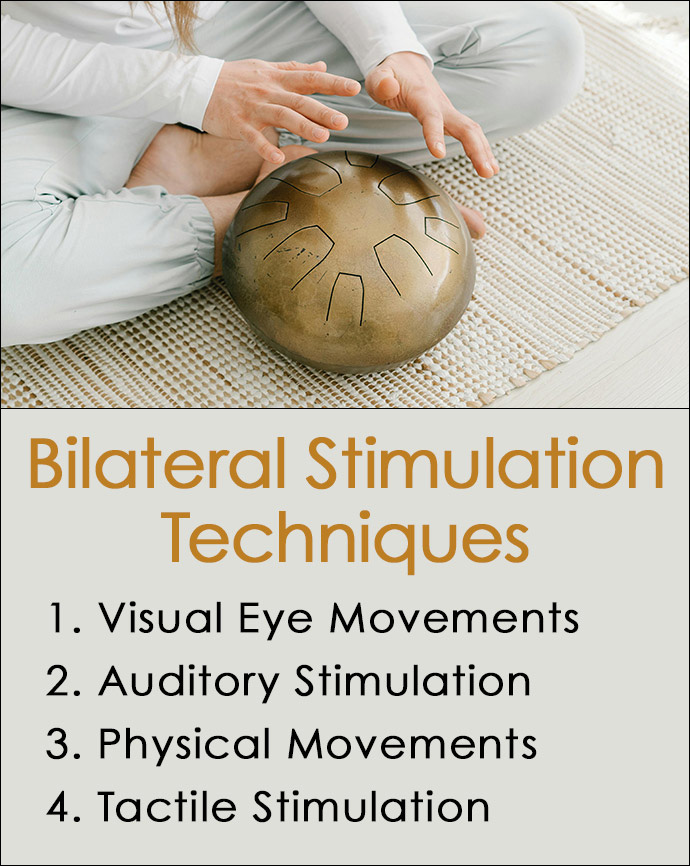
Bilateral Stimulation is a form of therapy that has shown to be effective for treating certain types of mental health issues like PTSD, anxiety, trauma disorders, and other conditions.
It is an integral part of EMDR treatment for PTSD, and it can be incorporated into formal therapy sessions as well as at home and daily activities.
Understanding how bilateral stimulation works and ways to use it effectively can help individuals reduce anxiety and overcome traumatic memories and emotional issues for improved mental health.
What is Bilateral Stimulation?
Bilateral stimulation is a therapeutic technique that alternately stimulates the left and right sides of the brain using visual, auditory, and other sensory inputs.
In biology, the term “bilateral” means, “relating to, or affecting the right and left sides of the body or the right and left members of paired organs.”
In the case of bilateral stimulation, it refers to arousing or activating both sides or hemispheres of the brain.
This technique was discovered in the 1980s by Dr. Francine Shapiro after she noticed that certain eye movements were connected to unhealthy thoughts and memories.
After further study, she used it as a main component to develop “eye movement desensitization and reprocessing,” better known as EMDR Therapy.
Today, EMDR is an evidence-based therapy that uses bilateral stimulation for treating PTSD and trauma-related disorders.
Bilateral stimulation for anxiety also works well for reducing anxious thoughts, stressful emotions, and other types of mental health disorders.
How Does Bilateral Stimulation Work?
Bilateral stimulation engages the brain in a unique way compared to other forms of therapy.
It uses bilateral movement to stimulate both sides of the brain.
This activates areas of the brain that are beneficial for reducing stress and unhealthy memories, while improving neural communication between the left and right hemispheres.

Benefits of Bilateral Stimulation
1. Activates Both Brain Hemispheres
By activating the left and right hemispheres of the brain, it improves neural communication to strengthen pathways in the brain and create new ones. This is helpful for integrating and processing traumatic memories and healing.
2. Stimulates the Parasympathetic Nervous System (PNS)
The Parasympathetic Nervous System acts as the brain’s brakes and helps to calm the mind from arousal of the fight or flight mechanism. When the brain is in a relaxed state, it decreases anxiety and is better able to focus.
Instead of being overwhelmed by a stressful situation or traumatic memory, the brain can process the events in a healthier way.
3. Increases Neurotransmitter Activity
Bilateral stimulation increases neurotransmitters, like dopamine and serotonin, which are known as happy hormones.
Boosting these “feel good chemicals” improves mood and happiness, while reducing anxiety and stress levels.
4. Orients the Brain
The Orienting Reflex theory proposes that bilateral brain stimulation keeps the brain engaged with the alternating tasks at hand.
By orienting the brain in this way, it keeps the mind from wandering to negative thoughts and memories that cause stress, and produces a calming effect, similar to mindfulness or meditation.
5. Engages Working Memory
The Working Memory Hypothesis theorizes that bilateral stimulation during EMDR Therapy causes the brain to focus on two tasks simultaneously: the thought of a traumatic memory and the alternating bilateral stimulus.
By focusing on both things at the same time, working memory is affected in a way that weakens the emotional impact of the traumatic memory and leads to improved healing.
When this happens, thinking becomes more open and flexible because the weight of distressing thoughts is diminished.
By improving neural communication, activating areas of the brain that calm the mind and improve mood, and reducing the severity of traumatic memories, bilateral stimulation can be an effective therapy for many people.
What Does Bilateral Stimulation Treat?
Bilateral stimulation is a core component EMDR Therapy, which many people associate with PTSD.
It is also effective for treating a number of other mental health conditions and issues like anxiety and depression.
1. PTSD – Post-Traumatic Stress Disorder
EMDR Therapy uses bilateral stimulation to address and heal Post-Traumatic Stress Disorder. It is probably best known for treating different types of PTSD by integrating past traumatic events into conscious memory and reducing the intensity of the memories to improve healing.
2. Trauma Disorders
While PTSD is the most well-known trauma condition, there are other types of trauma disorders that have a negative impact on a person’s mental health and wellness.
Secondary trauma symptoms are very similar to those of PTSD, but the cause of the condition is different, and may require a slightly different treatment approach.
3. Anxiety Disorders
Like trauma disorders, there are many types of anxiety disorders that produce unhealthy thinking and create difficulties with daily living and mental wellness.
Bilateral stimulation for anxiety is a powerful technique to reduce dwelling on negative memories and stressful events. It has shown to be beneficial for treating generalized anxiety disorder, social anxiety, panic disorders, and certain phobias.
4. Obsessive-Compulsive Disorder (OCD)
Obsessive-Compulsive Disorder is a specific type of anxiety disorder that causes an individual to be plagued by obsessive thoughts and compulsive behaviors that dominate daily life.
Bilateral brain stimulation helps to reprocess intrusive thoughts so they have less impact and to promote healthier behaviors.
5. Depression
Depression can be caused by obsessive rumination, negative thinking, neurotransmitter deficiencies, and other issues.
Bilateral stimulation addresses some of the causes of depression by reducing negative thinking and stimulating the Parasympathetic Nervous System and feel-good neurotransmitters to improve mood and mental wellness.
6. Stress Disorders
By focusing on the current task and stimulating both sides of the brain simultaneously, it produces a calming effect on the mind to better regulate emotions and decrease stress.
7. Addiction
Addiction changes the structure and functioning of the brain in unhealthy ways so that it no longer functions normally without drugs or alcohol. Traumatic memories and other forms of emotional pain are root causes of addiction for many people.
Bilateral stimulation can address some of the root causes of addiction to aid in the recovery process and help to restore normal brain functioning.
8. Eating Disorders and Chronic Pain
There is not much research yet on other disorders, but bilateral stimulation is considered a possible treatment approach for negative thinking that leads to eating disorders.
New studies have found that EMDR elements like bilateral sensory stimulation may have a positive impact on treating pain.
Bilateral Stimulation Techniques and Methods
There are various bilateral stimulation techniques and methods that can be used to produce beneficial results.
Each of these are associated with different sensory inputs and will stimulate both hemispheres of the brain.

1. Visual Eye Movements
The most common form of bilateral stimulation used with EMDR involves visual eye movements. A therapist moves a finger back and forth to guide the patient’s eyes in tracking the bilateral movement.
Sometimes a therapist uses a light or other objects for tracking eye movements that engage both sides of the patient’s brain.
Tracking the bilateral movement of an object on a screen or in a room can be just as effective.
2. Auditory Stimulation
An auditory bilateral stimulation technique uses sounds as a stimulus for engaging both sides of the brain. This is usually done while wearing headphones and listening to sounds or tones that alternate back and forth between the left and right ear.
Alternating the sound from one ear to the other improves communication between the brain’s hemispheres and strengthens or creates new pathways.
3. Physical Bilateral Movement
Physical bilateral movements that alternate between each side of the body stimulate both sides of the brain.
Walking, swimming, and dancing all require coordinated, rhythmic bilateral movements of the arms and legs at the same time and they are easy to do.
More difficult and intense bilateral physical movements include things like drumming or juggling.
The left side of the brain controls the right side of the body, and vice versa, so the entire brain is engaged with these types of physical movements.
4. Tactile Stimulation
The word “tactile” means “connected to the sense of touch.” Tactile stimulation is a technique that uses various sensory inputs that a person can touch and feel.
EMDR tappers and buzzers are devices that can be held in each hand or worn on both sides of body and produce vibrations or movements that alternate back and forth to stimulate both sides of the body. This in turn, engages both hemispheres of the brain.
In addition, a person can use their hands to tap different areas on each side of the body. One popular tactile stimulation technique is known as the “Butterfly Hug,” in which a person crosses both arms and alternates tapping the left and right arms or shoulders.
These different types of bilateral stimulation techniques offer options for those who might be uncomfortable using certain methods. Some people are more comfortable with tracking visual bilateral movement while others respond better to auditory or tactile stimuli.
Finding the most appropriate technique for each person will offer the most successful results.
Even though bilateral stimulation is a unique therapeutic approach most closely associated with EMDR therapy, it can also be used to stimulate both sides of the brain outside of therapy sessions.
It has shown to be beneficial for reducing anxiety, processing traumatic memories, and positively regulating emotions to improve mood and mental health.
Frequently Asked Questions
How Can I Do Bilateral Stimulation at Home?
Anyone can practice bilateral stimulation techniques at home or almost anywhere. It can be done while walking, swimming, or performing any activity that requires alternating bilateral movement of both sides of the body.
Practicing tapping exercises or the Butterfly Hug will engage both sides of the brain, and listening to music through headphones can create a calming effect.
Is Knitting a Form of Bilateral Stimulation?
Yes, knitting is a physical bilateral stimulation technique that requires an alternating, rhythmic movement between both hands.
It might also be considered a visual technique because alternating eye movements are required to focus and control the hand movements.
Are There Any Apps for Practicing Bilateral Stimulation?
“EMDR Tappers” is a bilateral stimulation therapy app available on the Apple store for IOS devices.
“Bilateral Stimulation Therapy” is a binaural EMDR app that is also available on the Apple store for IOS devices.
“Anxiety Release” is an app based on EMDR principles that uses alternating audio and visual cues to stimulate both sides of the brain. It is available for Android and IOS.
What are the Benefits of Bilateral Stimulation Compared to Other Therapy Methods?
Bilateral stimulation is often more effective for integrating and processing traumatic memories than talk therapy and similar treatment modalities. It also works more quickly at resolving traumatic memories.
Because it naturally stimulates the parasympathetic nervous system, it produces a calming effect to reduce anxiety and other stressors, while improving focus and concentration without the use of medications.
It enhances communication between both hemispheres of the brain and strengthens or creates new neural pathways.
The patient is an active participant in the treatment process, and it empowers them to take control of their recovery.
Related Posts
- EMDR Therapy for PTSD and Trauma Memories
EMDR Therapy is a unique alternative to traditional psychotherapy treatment for PTSD, trauma, and other…
- June is PTSD Awareness Month
Because trauma impacts so many people, June is recognized every year as PTSD Awareness Month.…
- Somatic Experiencing Therapy for Trauma Healing
Trauma or PTSD can be debilitating for many people, but fortunately a form of Somatic…
